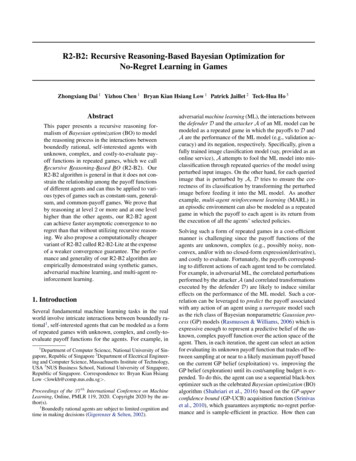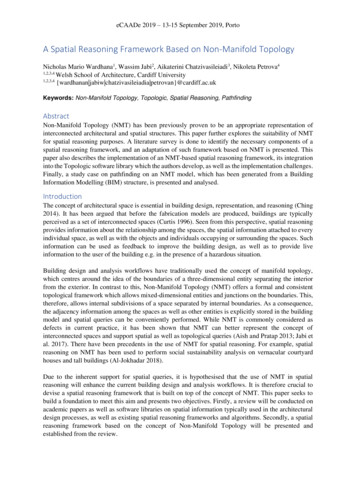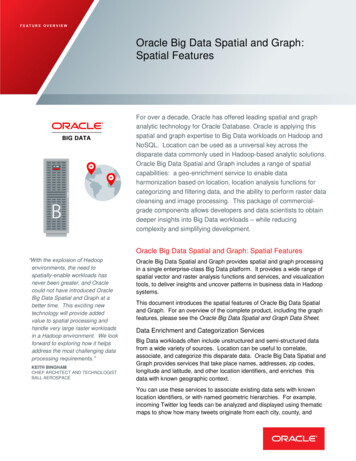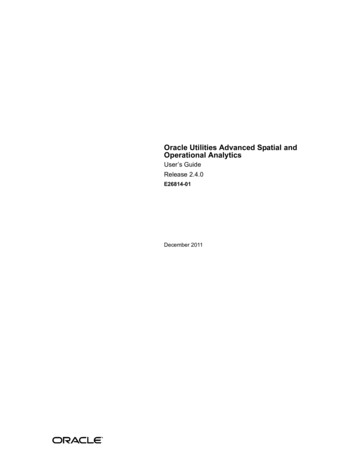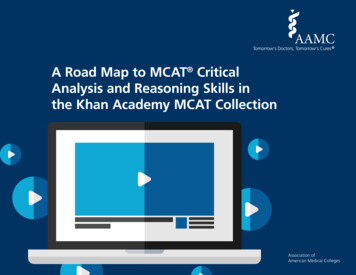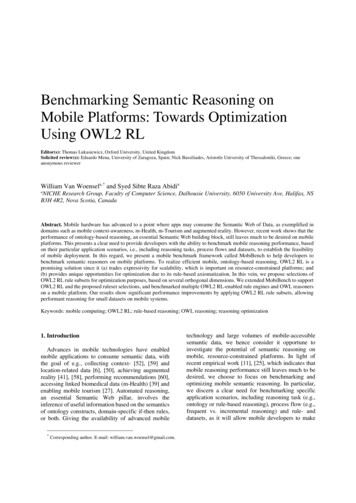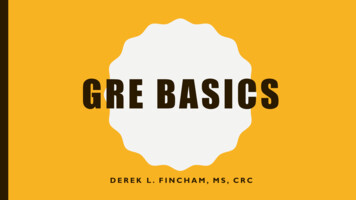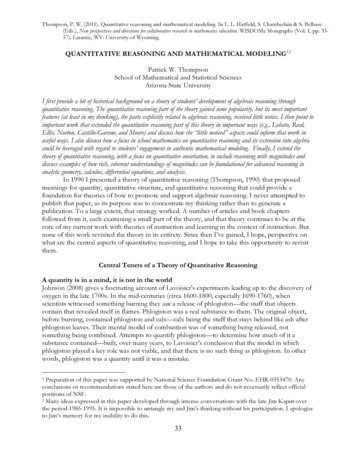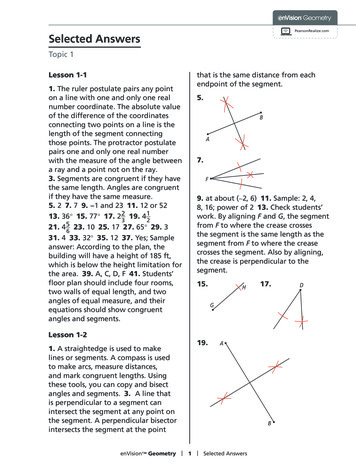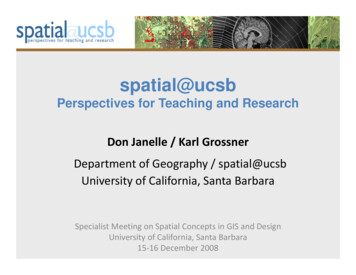
Transcription
spatial@ucsbPerspectives for Teaching and ResearchDon Janelle / Karl GrossnerDepartment of Geography / spatial@ucsbUniversity of California, Santa BarbaraSpecialist Meeting on Spatial Concepts in GIS and DesignUniversity of California, Santa Barbara15‐16 December 2008
Creative Studies Humanities & Fine Arts Social Sciences Engineering EducationNatural & Biological Sciences Environmental Sciences & ManagementCognition Perception Representation Visualization Computation Modeling Simulation Analysis ApplicationInformation-technology IntegrationApplying Concepts of Spatial Thinkingto Describe, Analyze, Understand &Predict, & to Create, Plan & Design . . .Space-time Patterns & Processes
Established 2007 to integrate a campus‐wide community of spatial thinkers at UCSBCENTER FOR THE ANALYSIS OF SACRED SPACEMike Goodchild, director of spatial@ucsb“spatial@ucsb aims to change what people thinkof spatial thinking – from something that onlyexperts need to know about, to something thateveryone should use.”UCSB is Spatial
A Natural / Structural Viewon the Space of KnowledgeGoodchild & Janelle12/18/2008Donald G. Janelle4
An Empirical / Pragmatic Viewon the Space of KnowledgeGoodchild & Janelle12/18/2008Donald G. Janelle5
Spatial thinking is transformativeGIS, Design, & beyond Value for daily living and for problem solving insociety and science Transcends disciplinary boundaries Unites quantitative and qualitative thinking Allies with multi-media graphic display andcommunication of information A domain of continuing significant knowledgedevelopment Not necessarily easily and intuitively acquired Candidate for inclusion in general education
Contrasting but Complementary PerspectivesSpatial Intelligence Learning Centerspatial@ucsbFocus: spatial cognition understanding spatial learning Improve K‐12 educationpractices to foster spatial skills &spatial functioningMethodology: Identify basic elements ofspatial thinking Controlled experiments tomeasure understanding,learning, & skill developmentFocus: Spatial concepts in social,environmental, behavioral, &design sciences Curriculum development forundergraduate educationMethodology: Identify fundamental spatialconcepts Context dependent applications(re: disciplines, theories,problems, policies) Tools of spatial analysis (e.g., GIS)
Geo‐spatial Concepts for Spatial Reasoning Location – Understanding formal & informal methods of specifying“where” Distance – The ability to reason from knowledge of relative position Network – Understanding the importance of connections Neighborhood & Region – Drawing inferences from spatial context Overlays – Inferring spatial associations by comparing mappedvariables by locations Scale – Understanding spatial scale & its significance Spatial Heterogeneity – The implications of spatial variability Spatial Dependence – Understanding relationships across space(Tobler’s First Law) Objects & Fields – Viewing phenomena as continuous in space‐timeor as discrete
Context Dependence across DisciplinesDisciplines claim uniqueness of theories, problems, and areas of application;yet also share fundamental objectives and methodologies Sciences seek identification and understanding of patterns and processes aboutthe physical world and its phenomena Social sciences focus on interdependence among people & groups, grounded inplace, space, & time and the need to understand patterns & processes of humanbehavior Engineering and design sciences focus on problem solving and productdevelopment that frequently entails the (re) arrangement of spatial entities and theconsequences Humanities focus on human creativity and aesthetic renderings (stories,visualizations, sounds) that often affirm affinity to sense of place and regional identity,use spatial metaphor, and rely on spatialized languages for communication
Initiatives by spatial@ucsb Workshop on spatial curriculum(hosted by University of Redlands, coordinated by Diana Sinton, June 2008) Specialist meeting on Spatial Concepts in GIS andDesign (Dec 2008) TeachSpatial.org (coming soon)
What can be accomplished at UCSB? Multi‐disciplinary Minor in spatial thinking Emphasis or Specialization in spatial thinking withinexisting degree programs Independent Studies (98/99; 198/199) Introduction to spatial thinking as part of existing courses General Education Course Freshman Seminar (Interdisciplinary 94) Multi‐discipline Graduate course (NSF IGERT ?)January 2009 planning meeting (computer science, environmental science,geography, history of art and architecture, mathematics, physics, psychology)
http://sand.spatial.ucsb.edu/teachspatial/
Thank YouPlease check www.spatial.ucsb.edufor information on applications of spatial thinking
Integrating Concepts for Spatio‐temporal ReasoningScientific and civic applications generally integrate multiple spatialconcepts simultaneously to engage general types of spatialreasoning to: (1) detect changes in the uses of space(s)(2) measure arrangements and clustering(3) document patterns over time to infer process(4) study flows as indicators of spatio‐temporal interactions(5) assess space‐time associations to test hypotheses
Questions (from the Redlands workshop) 1 Why is there interest in a general course on spatial thinking?Can we define “spatial literacy”?Who (what disciplines) should teach a course like this?Objectives?What spatial thinking concepts would be covered?How much should this course be guided by cognitive science?What might the syllabus look like?What online resources support development and delivery?What are valid and interesting forms of assessment?
Questions (from the Redlands workshop) 2 Is there a role within the general education framework for a courseon spatial thinking? Are there institutional impediments? Who are the other major players with interest in spatial thinking? Who might like to be aware of our activities? What types of funding could support this initiative? Other unanswered questions? Next steps?
Mike Goodchild, director of spatial@ucsb " spatial@ucsb aims to change what people think of spatial thinking -from something that only experts need to know about, to something that everyone should use." Established 2007 to integrate a campus‐wide community of spatial thinkers at UCSB
